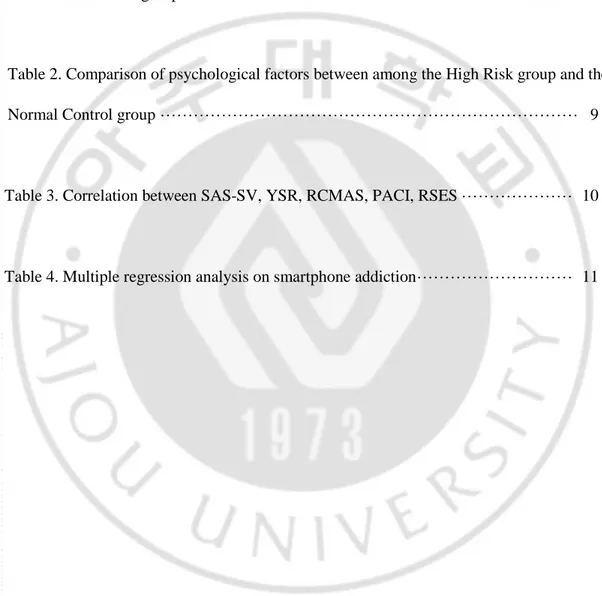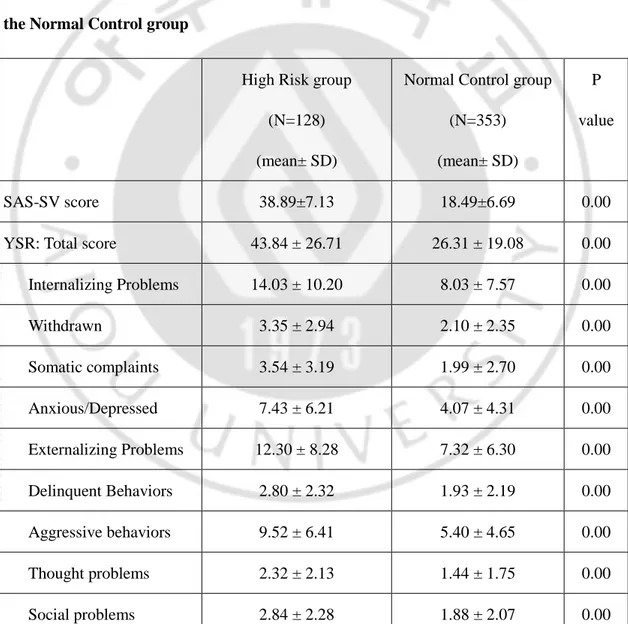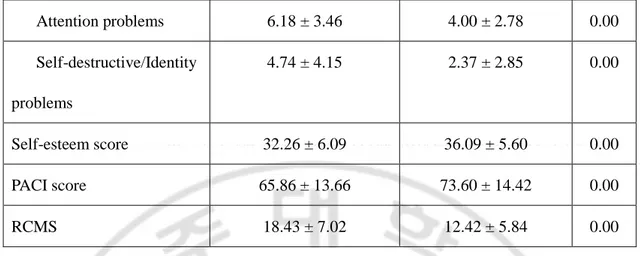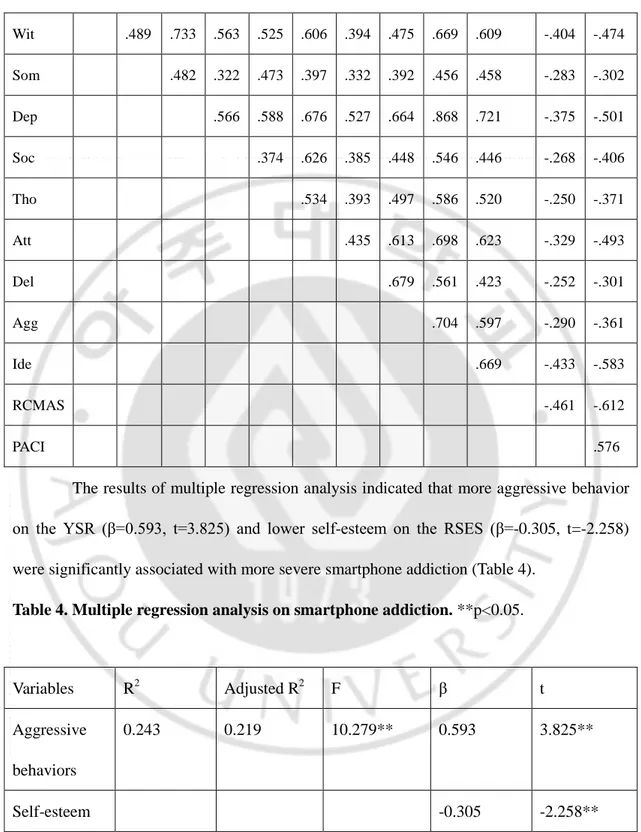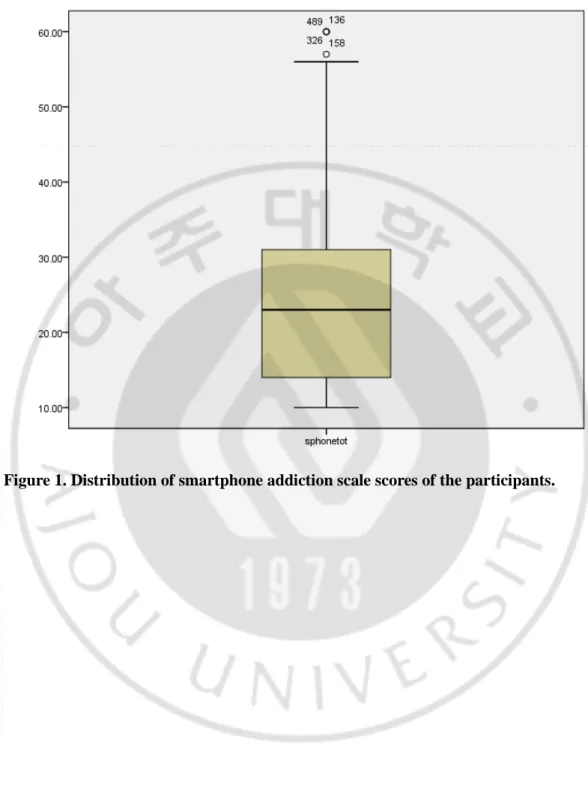저작자표시-비영리-변경금지 2.0 대한민국 이용자는 아래의 조건을 따르는 경우에 한하여 자유롭게 l 이 저작물을 복제, 배포, 전송, 전시, 공연 및 방송할 수 있습니다. 다음과 같은 조건을 따라야 합니다: l 귀하는, 이 저작물의 재이용이나 배포의 경우, 이 저작물에 적용된 이용허락조건 을 명확하게 나타내어야 합니다. l 저작권자로부터 별도의 허가를 받으면 이러한 조건들은 적용되지 않습니다. 저작권법에 따른 이용자의 권리는 위의 내용에 의하여 영향을 받지 않습니다. 이것은 이용허락규약(Legal Code)을 이해하기 쉽게 요약한 것입니다. Disclaimer 저작자표시. 귀하는 원저작자를 표시하여야 합니다. 비영리. 귀하는 이 저작물을 영리 목적으로 이용할 수 없습니다. 변경금지. 귀하는 이 저작물을 개작, 변형 또는 가공할 수 없습니다.
Psychological Factors associated with
Smartphone Addiction in Young Adolescents
by
Jeewon Lee
Major in Medicine
Department of Medical Sciences
The Graduate School, Ajou University
Psychological Factors associated with
Smartphone Addiction in Young Adolescents
by
Jeewon Lee
A Dissertation Submitted to The Graduate School of
Ajou University in Partial Fulfillment of the Requirements
for the Degree of
Ph.D. in Medicine
Supervised by
Yun-mi Shin, M.D.
Major in Medicine
Department of Medical Sciences
The Graduate School, Ajou University
- ABSTRACT-
Psychological factors associated with Smartphone Addiction in
Young Adolescents
The smartphone has many attractive attributes and characteristics that make it highly addictive, particularly in adolescents. The purpose of this study was to examine the prevalence of young adolescents in risk of smartphone addiction and the psychological factors associated with smartphone addiction. 490 middle-school students completed a self-questionnaire measuring levels of smartphone addiction, behavioral and emotional problems, self-esteem, anxiety, and adolescent-parent communication. 128(26.61%) adolescents were in high risk of smartphone addiction. Adolescents in high risk of smartphone addiction showed significantly more severe levels of behavioral and emotional problems, lower self-esteem and poorer quality of communication with their parents. Multiple regression analysis revealed that the severity of smartphone addiction was associated with aggressive behavior(β=0.593, t=3.825) and self-esteem(β=-0.305, t=-2.258). Further exploratory and confirmatory studies should consider different sites, demographics, technological mobile devices, platforms, and applications.
Keywords: adolescent, smartphone addiction, psychological factor, self-esteem, aggressive behavior
ii
TABLE OF CONTENTS
ABSTARCT ··· i
TABLE OF CONTENTS ··· ii
LIST OF FIGURES ··· iv
LIST OF TABLES ··· vii
I. INTRODUCTION ··· 1 II. METHODS ··· 4 A. Subjects ··· 4 B. Measurements ··· 4 C. Statistical analysis ··· 5 III. RESULTS ··· 7 IV. DISCUSSION ··· 12 V. CONCLUSION ··· 17 REFERENCES ··· 18 국문요약 ··· 24
LIST OF FIGURES
iv
LIST OF TABLES
Table 1. Comparison of sociodemographic characteristics between the High Risk group and the Normal Control group ··· 7
Table 2. Comparison of psychological factors between among the High Risk group and the Normal Control group ··· 9
Table 3. Correlation between SAS-SV, YSR, RCMAS, PACI, RSES ··· 10
I. INTRODUCTION
Internet addiction or problematic internet use has been the focus of attention for several years. Although not yet recognized as an established disorder, it is known that internet addiction has become a serious public health problem around the world, especially in adolescents (Christakis, 2010). Previous studies suggested that internet addiction increased the risk to suffer from a number of negative social and health consequences, such as poor academic performance, poor personality relationship, anxiety, depression, and other behavioral problems (Aboujaoude, 2010; Yang & Tung, 2007). However, with the rapid evolving development of technology, internet addiction doesn’t seem to be the only, neither the most serious cause of concern.
Most recently, smartphone addiction has been proposed as a diagnostic label to capture problems related to the drastic increase in use of smartphones. A smartphone is a relatively novel and innovative technology which typically combines the features of a mobile phone with those of other popular mobile devices, such as personal digital assistant, media player, GPS navigation unit, and etc.. A smartphone enables ubiquitous internet access, provides usage of various convenient applications, and offers unique opportunities for maintaining unrestricted and spontaneous contact with others (Sarwar & Soomro, 2013). The use of a smartphone has reached figures over 50% in most developed countries(van Deursen, Bolle, Hegner, & Kommers, 2015). Especially in South Korea, owing to its advanced IT development, over 24 million Koreans owned a smartphone in 2013, and 84% of adolescents owned a smartphone in 2014 (Alam et al., 2014).
- 2 -
Smartphones are becoming a necessity for many people’s daily lives, and they guarantee so much convenience to all the users. Particularly in adolescents, the smartphone has many attractive attributes and characteristics that make it highly addictive. It is known that adolescence represents a period of heightened biological vulnerability to addiction (Chambers, Taylor, & Potenza, 2014). The vast majority of people who suffer from addiction encountered the beginnings of their illness as adolescents (Wagner & Anthony, 2002). In case of the smartphone, adolescents are fascinated in embracing the new technology, with their greater motivational drives for novelty seeking, coupled with their immature inhibitory control system (Chambers et al., 2014). The possession and use of the smartphone by adolescents acknowledges personal autonomy, provides self-identity, offers entertainment, and favors establishment and maintenance of interpersonal relationships (Oksman & Turtiainen, 2004).
Studies have shown that addiction related to mobile or smartphone can lower academic performance, reduce offline activities, and cause family conflicts (Billieux, Van der Linden, & Rochat, 2008; Lobet-Maris, 2003). Also, its correlation with depression, anxiety, and sleep disturbance has been demonstrated (Jenaro, Flores, Gómez-Vela, González-Gil, & Caballo, 2007). Physically, excessive smartphone use may produce considerable stress on the cervical spine, thus changing the cervical curve and resulting in neck-shoulder pain (J. Park et al., 2015). Also, it has been reported that heightened anticipation about incoming phone calls or messages are associated with motor vehicle crash risk (O'Connor et al., 2013). Additionally, the smartphone is used as a medium of cyberbullying, and smartphone ownership and frequent use of smartphone significantly elevated the odds of becoming either
a cyber-bully or a cyber-victim (Englander, 2013).
The purpose of the present study was to examine the prevalence of young adolescents in high risk of smartphone addiction and psychological factors associated with smartphone addiction. We hypothesized that adolescents in high risk of smartphone addiction have more emotional and behavioral problems than others.
- 4 -
II. METHODS
A. Subjects
This cross-sectional survey was conducted in an all-boys-middle school in Gong-ju, a city in South Korea, in 2014. All the students and their parents provided a written informed consent after receiving an explanation on the study and assurance of confidentiality. The students were requested to complete the questionnaires in a classroom under the supervision of a research assistant. Total of 504 students participated in this research and 14 students were excluded due to incomplete questionnaires, resulting in 490 students.
B. Measurements
Smartphone Addiction Scale-Short Version(SAS-SV) is a self-report on smartphone addiction consisting of 10 items with a six-point scale(Kwon, Kim, Cho, & Yang, 2013). The 33 questions that were previously used for the Smartphone Addiction Scale were inefficient for the adolescent group due to its large number of questions and its use was limited to diagnose addiction as cut-off values were not suggested. SAS-SV is designed to identify the level of the smartphone addiction risk and to distinguish the high risk group. In case of SAS-SV, cut-off value of 31 for boys, and 33 for girls distinguished the high-risk group for smartphone addiction. Also, a higher overall score indicates greater severity of smartphone addiction.
Youth Self Report(YSR) is a prominent and widely used self-report measure for the assessment of emotional and behavioral problems, designed for adolescents ages 11 t0 18(Achenbach & Rescorla, 2001). 119 items on the YSR measure 8 sub-scale symptoms:
Withdrawn, Somatic Complaints, Anxiety/Depressed, Social Problems, Thought Problems, Attention Problems, Aggressive Behavior, and Delinquent behaviors. An additional scale, Self-Destructive/Identity problems may be scored for boys only. The sub-scales may be grouped into two broader scales. The Internalizing grouping consists of the sum of the scores of the Withdrawn, Somatic Complaints, and Anxious/Depressed scales. The Externalizing grouping consists of the sum of the scores of the Delinquent and Aggressive Behavior scales. Overall behavioral and emotional functioning is measured by the Total Problem Scale. An adolescent selects his or her response from 0(not true) to 2(very true or often true).
The Rosenberg Self-Esteem Scale(RSES) is a widely used self-report instrument for evaluating individual self-esteem(Rosenberg, 1965). A 10-item scale is answered using a 4-point Likert Scale format ranging from strongly agree to strongly disagree. The total score ranges from 10 to 40, with 10 representing the lowest level of self-esteem and 40 the highest.
The Parent-Adolescent Communication Inventory(PACI) is a 20-item instrument that was designed to measure both content and process issues related to communication between adolescents and their parents(Barnes & Olson, 1985). Higher score on the scale reflects better communication with one’s parents.
The Revised Children’s Manifest Anxiety Scale(RCMAS) is a self-reported screening tool to measure anxiety in children aged 6 to 19 years that has demonstrated good reliability and validity(Reynolds & Richmond, 1978). It consists of 37 items, each of which requires a yes or no answer. Higher scores on the RCMAS indicate greater levels of anxiety.
C. Statistical analysis
- 6 -
group according to the scores of SAS-SV, applying the suggested cut-off score of 31 for boys. Independent T-tests and Pearson chi-square tests were used to compare the sociodemographic characteristics and scores of YSR, RSES, PACI, and RCMAS between the two groups.
Second, correlation and multiple regression analyses were conducted to examine the relationship between smartphone addiction and the psychological factors. In multiple regression analyses, scores of SAS-SV was the dependent variable and the scores of YSR, RSES, PACI, and RCMAS were the predictor variables.
SPSS ver. 22.0 was used for the analyses, and significance level was set at 0.05. This study was approved by the ethics committee of Ajou University Medical Center.
III. RESULTS
The average age of the participants was 14 ± 0.89, composed of 131(24.7%) 7th
graders, 182(34.3%) 8th graders, 177(33.3%) 9th graders. 10(1.9%) reported being a smoker and 19(3.6%) had a drinking experience. 432(81.4%) lived with both parents, 36(6.8%) lived with one parent, and 22(4.1%) lived with neither. In regard to paternal education level, parents who had graduated college or more were most prevalent.
Among the 490 participants enrolled in the study, 9 were excluded because they didn’t own a smartphone. Thus, the smartphone ownership rate was 98.16%. Of the 481 participants who owned a smartphone, 128(26.61%) were classified in the high risk group of smartphone addiction, and the rest 353(73.39%) were classified in the normal control group. The sociodemographic characteristics between the two groups showed no significant difference (Table 1).
Table 1. Comparison of sociodemographic characteristics between the High Risk group and the Normal Control group
Variables High Risk group
(N=128)
Normal Control group (N=353) P Value Grade, n(%) 0.165 7 32(24.8) 97(75.2) 8 41(23.0) 137(77.0) 9 55(31.6) 119(68.4) Smoking, n(%) 0.633
- 8 - Yes 2(20.0) 8(80.0) No 126(26.8) 345(73.2) Drinking, n(%) 0.119 Yes 8(42.1) 11(57.9) No 120(26.0) 342(74.0)
Living with parent(s), n(%) 0.226
Both parents 108(25.4) 317(74.6)
One parent 13(38.2) 21(61.8)
None 7(31.8) 15(68.2)
Father education level, n(%)
College or more 63(26.4) 176(73.6)
High school 49(27.7) 128(72.3)
Middle school or less 2(22.2) 7(77.8)
Don’t’ know 14(25.0) 42(75.0)
Mother education level, n(%)
College or more 66(27.6) 173(72.4)
High school 46(25.4) 135(74.6)
Middle school or less 1(14.3) 6(85.7)
Don’t know 15(27.8) 39(72.2)
The mean severity of smartphone addiction on the SAS-SV was 23.92 (SD=11.30). The average SAS-SV score of the high risk group was 38.89±7.13 and that of the normal
control group was 18.49±6.69 (Table 2). The high risk group scored higher than the normal control group in the YSR, including all the scores of the 9 subscales, internalizing/externalizing problems, and the total score. The RSES score and the PACI score were lower in the high risk group, and the RCMAS score was higher in the high risk group compared to the normal control group. All the differences were statistically significant.
Table 2. Comparison of psychological factors between among the High Risk group and the Normal Control group
High Risk group (N=128) (mean± SD)
Normal Control group (N=353) (mean± SD)
P value
SAS-SV score 38.89±7.13 18.49±6.69 0.00
YSR: Total score 43.84 ± 26.71 26.31 ± 19.08 0.00
Internalizing Problems 14.03 ± 10.20 8.03 ± 7.57 0.00 Withdrawn 3.35 ± 2.94 2.10 ± 2.35 0.00 Somatic complaints 3.54 ± 3.19 1.99 ± 2.70 0.00 Anxious/Depressed 7.43 ± 6.21 4.07 ± 4.31 0.00 Externalizing Problems 12.30 ± 8.28 7.32 ± 6.30 0.00 Delinquent Behaviors 2.80 ± 2.32 1.93 ± 2.19 0.00 Aggressive behaviors 9.52 ± 6.41 5.40 ± 4.65 0.00 Thought problems 2.32 ± 2.13 1.44 ± 1.75 0.00 Social problems 2.84 ± 2.28 1.88 ± 2.07 0.00
- 10 - Attention problems 6.18 ± 3.46 4.00 ± 2.78 0.00 Self-destructive/Identity problems 4.74 ± 4.15 2.37 ± 2.85 0.00 Self-esteem score 32.26 ± 6.09 36.09 ± 5.60 0.00 PACI score 65.86 ± 13.66 73.60 ± 14.42 0.00 RCMS 18.43 ± 7.02 12.42 ± 5.84 0.00
Pearson’s correlations between smartphone addiction and subscales of the YSR, RESE, PACI, and RCMAS are shown in Table 3. The results indicated that smartphone addiction was positively correlated with withdrawn, somatic complaints, anxiety/depressed, social problems, thought problems, attention problems, delinquent problems, aggressive behavior, self-destructive/identity problems, and RCMAS. Smartphone addiction was negatively correlated with PACI and self-esteem score.
Table 3. Correlation between SAS-SV, YSR, RCMAS, PACI, RSES. SAS=Smartphone
Addiction Scale- short version, Wit=Withdrawn, Som=Somatic, Dep=Depression/Anxiety, Soc=Social problems, Tho=Thought problems, Att=Attention problems, Del=Delinquent problems, Agg=Aggressive behavior, Ide=Self-destructive/Identity problems, RCMAS=Revised Children’s Measured Anxiety Scale, PACI=Parent-Adolescent Communication Inventory, RSES=Rosenberg Self-Esteem Scale. *All coefficients had p-value <.000.
Wit Som Dep Soc Tho Att Del Agg Ide RCMAS PACI RSES SAS .287 .272 .345 .234 .265 .384 .257 .411 .406 .398 -.292 -.347
Wit .489 .733 .563 .525 .606 .394 .475 .669 .609 -.404 -.474 Som .482 .322 .473 .397 .332 .392 .456 .458 -.283 -.302 Dep .566 .588 .676 .527 .664 .868 .721 -.375 -.501 Soc .374 .626 .385 .448 .546 .446 -.268 -.406 Tho .534 .393 .497 .586 .520 -.250 -.371 Att .435 .613 .698 .623 -.329 -.493 Del .679 .561 .423 -.252 -.301 Agg .704 .597 -.290 -.361 Ide .669 -.433 -.583 RCMAS -.461 -.612 PACI .576
The results of multiple regression analysis indicated that more aggressive behavior on the YSR (β=0.593, t=3.825) and lower self-esteem on the RSES (β=-0.305, t=-2.258) were significantly associated with more severe smartphone addiction (Table 4).
Table 4. Multiple regression analysis on smartphone addiction. **p<0.05.
Variables R2 Adjusted R2 F β t
Aggressive behaviors
0.243 0.219 10.279** 0.593 3.825**
- 12 -
IV. DISCUSSION
In this study, 26.61% of the enrolled adolescents were in high risk of smartphone addiction. Among the studies which used the same scale as the present study, SAS-SV, prevalence of young adults in risk of smartphone addiction was estimated as 16.9%, 12.8%, 21.5% in Switzerland, Spain, and Belgium, respectively(Haug et al., 2015; Lopez-Fernandez, 2015). Such higher rate of smartphone addiction in this study could be due to Korea’s high use of smartphone. As South Korea prides itself on being the global leader in high-speed Internet and advanced mobile technology, its rate of smartphone ownership is among the highest in the world (Alam et al., 2014; Lee et al., 2014).
As we hypothesized, adolescents in high risk of smartphone addiction showed significantly more severe levels of psychopathologies, including withdrawn, somatic complaints, social problems, thought problems, attention problems, aggressive behavior, delinquent behavior, self-destructive/identity problems, anxiety and depression. Also, those in high risk of smartphone addiction showed lower self-esteem, higher levels of anxiety, and poorer quality of communication with their parents. Our results of multiple regression analysis revealed that the severity of smartphone addiction is associated with high level of aggressive behavior and low self-esteem. However, only 21.9% of the variance in behavioral consequences was explained with the model.
Many studies have revealed a close relationship between aggression and internet addiction. In terms of specific contents, online chatting, pornography, online gaming, and online gambling were all found to be associated with aggressive behavior (Ko, Yen, Liu,
Huang, & Yen, 2009). Zimbardo proposed that on the internet, anonymity and loss of individual responsibility results in a deindividuated state of oneself (Zimbardo, 1969). Deindividuation effect would lead to decreased self-observation or self-awareness, minimize the concern for social evaluation, weaken controls based on guilt, shame, and fear, and then lower the threshold for exhibiting proscribed socially inhibited behaviors (Reicher, Spears, & Postmes, 1995) It can be postulated that since smartphone enables one to access the internet more easily and more frequently, impact of aggression on smartphone could be even greater than that on the internet. Moreover, participants in our study were all male. It is known that men are more aggressive than women, possibly due to the differences in social roles and biological features between sexes (Lightdale & Prentice, 1994). Therefore, we may assume that male students would use more aggressive online contents (K. Kim, 2013), which could have affected our study result.
Low self-esteem is one of the characteristics of the addictive personality (Marlatt, Baer, Donovan, & Kivlahan, 1988). Individuals who do not value themselves highly are more likely to bow to peer pressure which makes them vulnerable to engage in addictive behaviors (Zimmerman, Copeland, Shope, & Dielman, 1997). Also, lack of self-worth can keep people trapped in addiction (Marlatt et al., 1988). In case of smartphone addiction, low self-esteem has been proposed to be predictors of mobile phone and smartphone addiction (Ha, Chin, Park, Ryu, & Yu, 2008). In a study which examined the profiles of smartphone addicts, low self-esteem, fear of rejection and need for approval were found to be important characteristics of smartphone addicts (Lapointe, Boudreau-Pinsonneault, & Vaghefi, 2013). The supportive function of peer relationships is particularly decisive in adolescence (Brown
- 14 -
& Larson, 2009). Adolescents with low self-esteem or negative self-image may tend to seek reassurance and intimacy in the virtual world where they would build a new, confident self (Lapointe et al., 2013).
The result of this study could also be explained in the context of South Korea’s society which puts great emphasis on academic achievement for adolescents (B. Kim, Lee, Kim, Choi, & Lee, 2015). Korean adolescents are known to have heavy schoolwork, highly-competitive social atmosphere, and high expectations for good academic performance. The average amount of time Korean adolescents devote in studying was 7 hours 50 minutes per day, which was much longer than that of other countries, which ranged from 3 to 6 hour (The State of Korean Children and Adolescents Seoul, 2009). Inevitably, Korean adolescents experience high levels of stress due to problems associated with academic performance, and academic stress is found to be a main predictive factor for aggression (M. Park, Choi, & Lim, 2014). At the same time, Korean adolescents spent less time sleeping (7 hours 30 minutes per day) and exercising (13 minutes per day) than other adolescents from England, the United States of America, Holland, Sweden, and Finland (The State of Korean Children and Adolescents Seoul, 2009). Exercise allows for a discharge of aggression, reduces emotional strain, and promotes elevated self-esteem (Gerber, Kellmann, Hartmann, & Pühse, 2010). Low levels of physical activity, poor sleep, and high academic stress are reported to be contributors to the high prevalence of problematic internet use in Korean adolescents (S. Park, 2014). It could be suggested that we attribute the relatively high prevalence of smartphone addiction in this study and its correlation with aggression and self-esteem to high academic stress and low levels of physical activity of Korean adolescents. Further studies on
the relationship between adolescent’s smartphone addiction and academic stress and levels of physical activity are needed.
This study has several limitations that need to be addressed. First, the generalizability of this research may be limited by the characteristics of our participants, since it is a single-site study with all male participants. Second, because of the cross-sectional and correlational nature of the study, the current study alone is insufficient to provide evidence of causal relationships. Especially many socio-demographic factors that could have affected both smartphone addiction and emotional and behavioral problems were not controlled. The implementation of analytical methods, that can examine causal relationships, rather than merely examining the degree of associations, is recommended so that antecedents and consequences of smartphone addiction can be clearly evaluated. Third, we only evaluated the severity of smartphone addiction, but examining the contents and patterns of smartphone use would have been useful. Many insist that problems arise from various activities enabled by the internet rather than the medium itself (Van Rooij, Schoenmakers, Van de Eijnden, & Van de Mheen, 2010). Fourth, our results based on self-reported questionnaires could suffer from social desirability bias. Lastly, the validity of the cut-off score of SAS-SV which we used to distinguish the high risk group of smartphone addiction could be questioned. The cut-off value of 31 for boys in SAS-SV had a positive value of 62% and a negative predictive value of 97%(Kwon et al., 2013). Figure 1 shows the distribution of SAS-SV scores of the participants in this study, and the cut-off score of 31 does seem adequate.
- 16 -
V. CONCLUSION
The current study provided empirical evidence to increase our understanding of smartphone addiction. We found that young adolescents in risk of smartphone addiction show more severe levels of behavioral and emotional problems, lower self-esteem and poorer quality of communication with their parents compared to those in normal risk. Particularly we found association between smartphone addiction and aggressive behavior and self-esteem. We emphasize the importance of continued research not only in the area of smartphone, but also in other areas of information technology. Further exploratory and confirmatory studies should consider different sites, demographics, technological mobile devices/platforms, and applications.
- 18 -
REFERENCES
Aboujaoude, E. (2010). Problematic Internet use: an overview. World Psychiatry, 9(2), 85-90.
Achenbach, T., & Rescorla, L. (2001). Manual for the ASEBA school-age forms & profiles: an integrated system of multi-informant assessment Burlington, VT: University of Vermont. Research Center for Children, Youth, & Families. Alam, M., Qureshi, M. S., Sarwat, A., Haque, Z., Salman, M., Masroor, M. A. M., . . .
Ehtesham, S. A. (2014). Prevalence of Phantom Vibration Syndrome and Phantom Ringing Syndrome (Ringxiety): Risk of Sleep Disorders and Infertility among Medical Students. Int J [Internet], 2(12), 688-693.
Barnes, H. L., & Olson, D. H. (1985). Parent-adolescent communication and the circumplex model. Child development, 438-447.
Billieux, J., Van der Linden, M., & Rochat, L. (2008). The role of impulsivity in actual and problematic use of the mobile phone. Applied Cognitive Psychology, 22(9), 1195-1210.
Brown, B. B., & Larson, J. (2009). Peer relationships in adolescence. Handbook of adolescent psychology.
Chambers, R. A., Taylor, J. R., & Potenza, M. N. (2014). Developmental neurocircuitry of motivation in adolescence: a critical period of addiction vulnerability.
8(1), 61.
Englander, E. K. (2013). Understanding Cyberbullying in 8-to-10 Year Olds: New Research. Paper presented at the 2013 AAP National Conference and Exhibition.
Gerber, M., Kellmann, M., Hartmann, T., & Pühse, U. (2010). Do exercise and fitness buffer against stress among Swiss police and emergency response service officers? Psychology of Sport and Exercise, 11(4), 286-294.
Ha, J. H., Chin, B., Park, D.-H., Ryu, S.-H., & Yu, J. (2008). Characteristics of excessive cellular phone use in Korean adolescents. CyberPsychology & Behavior, 11(6), 783-784.
Haug, S., Castro, R. P., Kwon, M., Filler, A., Kowatsch, T., & Schaub, M. P. (2015). Smartphone use and smartphone addiction among young people in Switzerland. Journal of behavioral addictions, 4(4), 299-307.
Jenaro, C., Flores, N., Gómez-Vela, M., González-Gil, F., & Caballo, C. (2007). Problematic internet and cell-phone use: Psychological, behavioral, and health correlates. Addiction research & theory, 15(3), 309-320.
Kim, B., Lee, M., Kim, K., Choi, H., & Lee, S. M. (2015). Longitudinal analysis of academic burnout in Korean middle school students. Stress and Health, 31(4), 281-289.
Kim, K. (2013). Association between Internet overuse and aggression in Korean adolescents. Pediatrics International, 55(6), 703-709.
- 20 -
associations between aggressive behaviors and Internet addiction and online activities in adolescents. Journal of Adolescent Health, 44(6), 598-605. Kwon, M., Kim, D.-J., Cho, H., & Yang, S. (2013). The smartphone addiction scale:
development and validation of a short version for adolescents. PloS one, 8(12), e83558.
Lapointe, L., Boudreau-Pinsonneault, C., & Vaghefi, I. (2013). Is Smartphone usage truly smart? A qualitative investigation of IT addictive behaviors. Paper presented at the System Sciences (HICSS), 2013 46th Hawaii International Conference on.
Lee, U., Lee, J., Ko, M., Lee, C., Kim, Y., Yang, S., . . . Song, J. (2014). Hooked on smartphones: an exploratory study on smartphone overuse among college students. Paper presented at the Proceedings of the 32nd annual ACM conference on Human factors in computing systems.
Lightdale, J. R., & Prentice, D. A. (1994). Rethinking sex differences in aggression: Aggressive behavior in the absence of social roles. Personality and Social Psychology Bulletin, 20(1), 34-44.
Lobet-Maris, C. (2003). Mobile phone tribes: Youth and social identity. Mediating the human body: Technology, communications and fashion, 87-92.
Lopez-Fernandez, O. (2015). Short version of the Smartphone Addiction Scale adapted to Spanish and French: Towards a cross-cultural research in problematic mobile phone use. Addictive behaviors.
behaviors: Etiology and treatment. Annual review of Psychology, 39(1), 223-252.
O'Connor, S. S., Whitehill, J. M., King, K. M., Kernic, M. A., Boyle, L. N., Bresnahan, B. W., . . . Ebel, B. E. (2013). Compulsive cell phone use and history of motor vehicle crash. Journal of Adolescent Health, 53(4), 512-519.
Oksman, V., & Turtiainen, J. (2004). Mobile communication as a social stage meanings of mobile communication in everyday life among teenagers in Finland. New Media & Society, 6(3), 319-339.
Park, J., Kim, J., Kim, J., Kim, K., Kim, N., Choi, I., . . . Yim, J. (2015). The effects of heavy smartphone use on the cervical angle, pain threshold of neck muscles and depression.
Park, M., Choi, J., & Lim, S.-J. (2014). Factors affecting aggression in South Korean middle school students. Asian nursing research, 8(4), 247-253.
Park, S. (2014). Associations of physical activity with sleep satisfaction, perceived stress, and problematic Internet use in Korean adolescents. BMC public health, 14(1), 1.
Reicher, S. D., Spears, R., & Postmes, T. (1995). A social identity model of deindividuation phenomena. European review of social psychology, 6(1), 161-198.
Reynolds, C. R., & Richmond, B. O. (1978). What I think and feel: A revised measure of children's manifest anxiety. Journal of abnormal child psychology, 6(2), 271-280.
- 22 -
Rosenberg, M. (1965). Society and the adolescent self-image: Princeton University Press Princeton, NJ.
Sarwar, M., & Soomro, T. R. (2013). Impact of smartphone's on society. European Journal of Scientific Research(98).
. The State of Korean Children and Adolescents Seoul. (2009).
van Deursen, A. J., Bolle, C. L., Hegner, S. M., & Kommers, P. A. (2015). Modeling habitual and addictive smartphone behavior: The role of smartphone usage types, emotional intelligence, social stress, self-regulation, age, and gender. Computers in Human Behavior, 45, 411-420.
Van Rooij, A. J., Schoenmakers, T. M., Van de Eijnden, R. J., & Van de Mheen, D. (2010). Compulsive internet use: the role of online gaming and other internet applications. Journal of Adolescent Health, 47(1), 51-57.
Wagner, F. A., & Anthony, J. C. (2002). From first drug use to drug dependence: developmental periods of risk for dependence upon marijuana, cocaine, and alcohol.
Yang, S. C., & Tung, C.-J. (2007). Comparison of Internet addicts and non-addicts in Taiwanese high school. Computers in Human Behavior, 23(1), 79-96.
Zimbardo, P. G. (1969). The human choice: Individuation, reason, and order versus deindividuation, impulse, and chaos. Paper presented at the Nebraska symposium on motivation.
Zimmerman, M. A., Copeland, L. A., Shope, J. T., & Dielman, T. E. (1997). A longitudinal study of self-esteem: Implications for adolescent development.
- 24 - - 국문요약 -

